据说,Transformer 不能有效地进行时间序列预测?
简介
几个月前,我们介绍了 Informer 这个模型,相关论文 (Zhou, Haoyi, et al., 2021) 是一篇获得了 AAAI 2021 最佳论文奖的时间序列论文。我们也展示了一个使用 Informer 进行多变量概率预测的例子。在本文中,我们讨论以下问题: Transformer 模型对时间序列预测真的有效吗?我们给出的答案是,它们真的有效。
首先,我们将会提供一些实验证据,展示其真正的有效性。我们的对比实验将表明, DLinear 这个简单线性模型并没有像说的那样比 transformer 好。当我们在同等模型大小和相同设定的情况下对比时,我们发现基于 transformer 的模型在我们关注的测试标准上表现得更好。其次,我们将会介绍 Autoformer 模型,相关论文 (Wu, Haixu, et al., 2021) 在 Informer 模型问世后发表在 NeurIPS 2021 上。Autoformer 的模型现在已经可以在 Transformers 中 使用。最后,我们还会讨论 DLinear 模型,该模型是一个简单的前向网络,使用了 Autoformer 中的分解层 (decomposition layer)。DLinear 模型是在 Are Transformers Effective for Time Series Forecasting? 这篇论文中提出的,文中声称其性能在时间序列预测领域超越了 transformer 系列的算法。
下面我们开始!
评估 Transformer 系列模型 和 DLinear 模型
在 AAAI 2023 的论文 Are Transformers Effective for Time Series Forecasting? 中,作者声称 transformer 系列模型在时间序列预测方面并不有效。他们拿基于 transformer 的模型与一个简单的线性模型 DLinear 作对比。DLinear 使用了 Autoformer 中的 decomposition layer 结构 (下文将会介绍),作者声称其性能超越了基于 transformer 的模型。但事实真的是这样吗?我们接下来看看。
| Dataset | Autoformer (uni.) MASE | DLinear MASE |
|---|---|---|
Traffic |
0.910 | 0.965 |
Exchange-Rate |
1.087 | 1.690 |
Electricity |
0.751 | 0.831 |
上表展示了 Autoformer 和 DLinear 在三个论文中用到的数据集上的表现。结果说明 Autoformer 在三个数据集上表现都超越了 DLinear 模型。
接下来,我们将介绍 Autoformer 和 DLinear 模型,演示我们如何在上表 Traffic 数据集上对比它们的性能,并为结果提供一些可解释性。
先说结论: 一个简单的线性模型可能在某些特定情况下更有优势,但可能无法像 transformer 之类的复杂模型那样处理协方差信息。
Autoformer 详细介绍
Autoformer 基于传统的时间序列方法: 把时间序列分解为季节性 (seasonality) 以及趋势 - 周期 (trend-cycle) 这些要素。这通过加入分解层 ( Decomposition Layer ) 来实现,以此来增强模型获取这些信息的能力。此外,Autoformer 中还独创了自相关 (auto-correlation) 机制,替换掉了传统 transformer 中的自注意力 (self-attention)。该机制使得模型可以利用注意力机制中周期性的依赖,提升了总体性能。
下面,我们将深入探讨 Autoformer 的这两大主要贡献: 分解层 ( Decomposition Layer ) 和自相关机制 ( Autocorrelation Mechanism )。相关代码也会提供出来。
分解层
分解是一个时间序列领域十分常用的方法,但在 Autoformer 以前都没有被密集集成入深度学习模型中。我们先简单介绍这一概念,随后会使用 PyTorch 代码演示这一思路是如何应用到 Autoformer 中的。
时间序列分解
在时间序列分析中,分解 (decomposition) 是把一个时间序列拆分成三个系统性要素的方法: 趋势周期 (trend-cycle) 、季节性变动 (seasonal variation) 和随机波动 (random fluctuations)。趋势要素代表了时间序列的长期走势方向; 季节要素反映了一些反复出现的模式,例如以一年或一季度为周期出现的模式; 而随机 (无规律) 因素则反映了数据中无法被上述两种要素解释的随机噪声。
有两种主流的分解方法: 加法分解和乘法分解,这在 statsmodels 这个库里都有实现。通过分解时间序列到这三个要素,我们能更好地理解和建模数据中潜在的模式。
但怎样把分解集成进 transformer 结构呢?我们可以参考参考 Autoformer 的做法。
Autoformer 中的分解
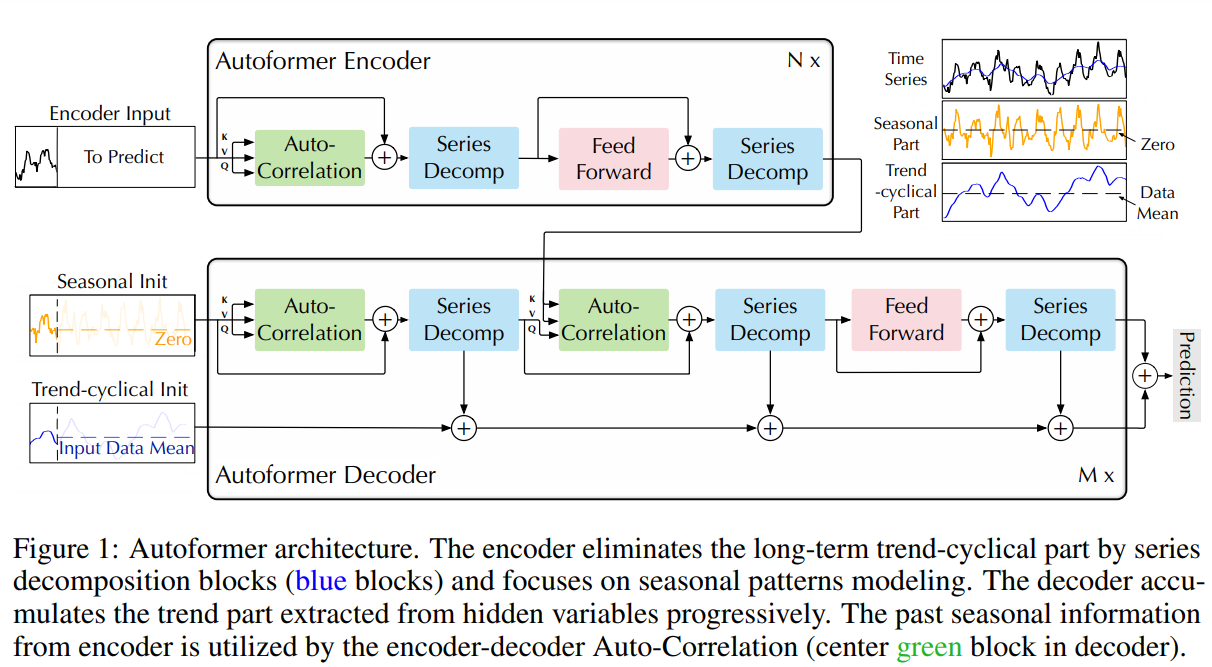 |
|---|
| Autoformer 结构 (来自论文) |
Autoformer 把分解作为一个内部计算操作集成到模型中,如上图所示。可以看到,编码器和解码器都使用了分解模块来集合 trend-cyclical 信息,并从序列中渐进地提取 seasonal 信息。这种内部分解的概念已经从 Autoformer 中展示了其有效性。所以很多其它的时间序列论文也开始采用这一方法,例如 FEDformer (Zhou, Tian, et al., ICML 2022) 和 DLinear (Zeng, Ailing, et al., AAAI 2023),这更说明了其在时间序列建模中的意义。
现在,我们正式地给分解层做出定义:
对一个长度为 \(L\) 的序列 \(\mathcal{X} \in \mathbb{R}^{L \times d}\),分解层返回的 \(\mathcal{X}_\textrm{trend} 和 \mathcal{X}_\textrm{seasonal}\) 定义如下:
\mathcal{X}_\textrm{seasonal} = \mathcal{X} - \mathcal{X}_\textrm{trend}
\]
对应的 PyTorch 代码实现是:
import torch
from torch import nn
class DecompositionLayer(nn.Module):
"""
Returns the trend and the seasonal parts of the time series.
"""
def __init__(self, kernel_size):
super().__init__()
self.kernel_size = kernel_size
self.avg = nn.AvgPool1d(kernel_size=kernel_size, stride=1, padding=0) # moving average
def forward(self, x):
"""Input shape: Batch x Time x EMBED_DIM"""
# padding on the both ends of time series
num_of_pads = (self.kernel_size - 1) // 2
front = x[:, 0:1, :].repeat(1, num_of_pads, 1)
end = x[:, -1:, :].repeat(1, num_of_pads, 1)
x_padded = torch.cat([front, x, end], dim=1)
# calculate the trend and seasonal part of the series
x_trend = self.avg(x_padded.permute(0, 2, 1)).permute(0, 2, 1)
x_seasonal = x - x_trend
return x_seasonal, x_trend
可见,代码非常简单,可以很方便地用在其它模型中,正如 DLinear 那样。下面,我们讲解第二个创新点: 注意力 (自相关) 机制 。
注意力 (自相关) 机制
 |
|---|
| 最原始的注意力机制和自相关机制 (图片来自论文) |
除了分解层之外,Autoformer 还使用了一个原创的自相关 (autocorrelation) 机制,可以完美替换自注意力 (self-attention) 机制。在 最原始的时间序列 transformer 模型 中,注意力权重是在时域计算并逐点聚合的。而从上图中可以看出,Autoformer 不同的是它在频域计算这些 (使用 快速傅立叶变换),然后通过时延聚合它们。
接下来部分,我们深入细节,并使用代码作出讲解。
时域的注意力机制
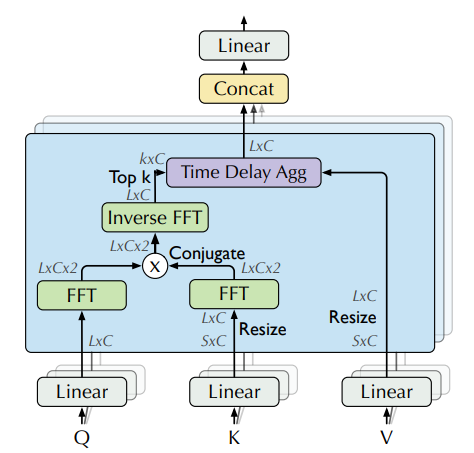 |
|---|
| 借助 FFT 在频域计算注意力权重 (图片来自论文) |
理论上讲,给定一个时间延迟 \(\tau\),一个离散变量的 自相关性 \(y\) 可以用来衡量这个变量当前时刻 \(t\) 的值和过去时刻 \(t-\tau\) 的值之间的“关系”(皮尔逊相关性,pearson correlation):
\]
使用自相关性,Autoformer 提取了 query 和 key 之间基于频域的相互依赖,而不是像之前那样两两之间的点乘。可以把这个操作看成是自注意力中 \(QK^T\) 的替换。
实际操作中,query 和 key 之间的自相关是通过 FFT 一次性针对 所有时间延迟 计算出来的。通过这种方法,自相关机制达到了 \(O(L \log L)\) 的时间复杂度 ( \(L\) 是输入时间长度),这个速度和 Informer 的 ProbSparse attention 接近。值得一提的是,使用 FFT 计算自相关性的理论基础是 Wiener–Khinchin theorem,这里我们不细讲了。
现在,我们来看看相应的 PyTorch 代码:
import torch
def autocorrelation(query_states, key_states):
"""
Computes autocorrelation(Q,K) using `torch.fft`.
Think about it as a replacement for the QK^T in the self-attention.
Assumption: states are resized to same shape of [batch_size, time_length, embedding_dim].
"""
query_states_fft = torch.fft.rfft(query_states, dim=1)
key_states_fft = torch.fft.rfft(key_states, dim=1)
attn_weights = query_states_fft * torch.conj(key_states_fft)
attn_weights = torch.fft.irfft(attn_weights, dim=1)
return attn_weights
代码非常简洁! 请注意这只是 autocorrelation(Q,K) 的部分实现,完整实现请参考 Transformers 中的代码。
接下来,我们将看到如何使用时延值聚合我们的 attn_weights ,这个过程被称为时延聚合 ( Time Delay Aggregation )。
时延聚合
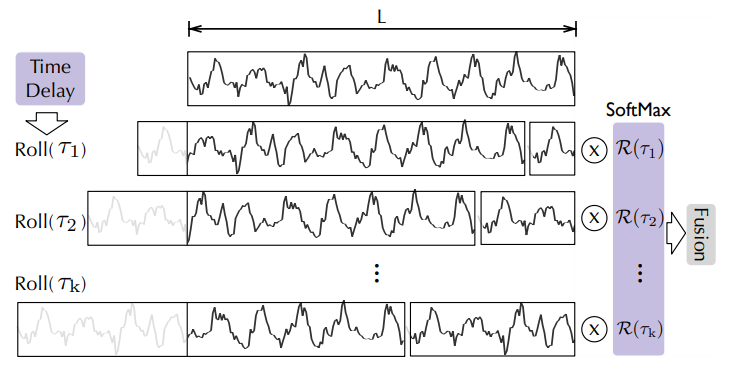 |
|---|
| 通过时延来聚合,图片来自 Autoformer 论文 |
我们用 \(\mathcal{R_{Q,K}}\) 来表示自相关 (即 attn_weights )。那么问题是: 我们应该如何聚合这些 \(\mathcal{R_{Q,K}}(\tau_1), \mathcal{R_{Q,K}}(\tau_2), …, \mathcal{R_{Q,K}}(\tau_k)\) 到 \(\mathcal{V}\) 上面?在标准的自注意力机制中,这种聚合通过点乘完成。但在 Autoformer 中,我们使用了一种不同的方法。首先我们在时延 \(\tau_1, \tau_2, … \tau_k\) 上对齐 \(\mathcal{V}\),计算在这些时延下它对应的值,这个操作叫作 Rolling 。接下来,我们将对齐的 \(\mathcal{V}\) 和自相关的值进行逐点的乘法运算。在上图中,你可以看到在左边是基于时延对 \(\mathcal{V}\) 进行的 Rolling 操作; 而右边就展示了与自相关进行的逐点乘法。
整个过程可以用以下公式总结:
\hat{\mathcal{R}}\mathcal{ _{Q,K}}(\tau _1), \hat{\mathcal{R}}\mathcal{_ {Q,K}}(\tau _2), …, \hat{\mathcal{R}}\mathcal{_ {Q,K}}(\tau _k) = \textrm{Softmax}(\mathcal{R_ {Q,K}}(\tau _1), \mathcal{R_ {Q,K}}(\tau_2), …, \mathcal{R_ {Q,K}}(\tau_k)) \
\textrm{Autocorrelation-Attention} = \sum_{i=1}^k \textrm{Roll}(\mathcal{V}, \tau_i) \cdot \hat{\mathcal{R}}\mathcal{_{Q,K}}(\tau _i)
\]
就是这样!需要注意的是,\(k\) 是一个超参数,我们称之为 autocorrelation_factor (类似于 Informer 里的 sampling_factor ) ; 而 softmax 是在乘法操作之前运用到自相关上面的。
现在,我们已经可以看看最终的代码了:
import torch
import math
def time_delay_aggregation(attn_weights, value_states, autocorrelation_factor=2):
"""
Computes aggregation as value_states.roll(delay)* top_k_autocorrelations(delay).
The final result is the autocorrelation-attention output.
Think about it as a replacement of the dot-product between attn_weights and value states.
The autocorrelation_factor is used to find top k autocorrelations delays.
Assumption: value_states and attn_weights shape: [batch_size, time_length, embedding_dim]
"""
bsz, num_heads, tgt_len, channel = ...
time_length = value_states.size(1)
autocorrelations = attn_weights.view(bsz, num_heads, tgt_len, channel)
# find top k autocorrelations delays
top_k = int(autocorrelation_factor * math.log(time_length))
autocorrelations_mean = torch.mean(autocorrelations, dim=(1, -1)) # bsz x tgt_len
top_k_autocorrelations, top_k_delays = torch.topk(autocorrelations_mean, top_k, dim=1)
# apply softmax on the channel dim
top_k_autocorrelations = torch.softmax(top_k_autocorrelations, dim=-1) # bsz x top_k
# compute aggregation: value_states.roll(delay)* top_k_autocorrelations(delay)
delays_agg = torch.zeros_like(value_states).float() # bsz x time_length x channel
for i in range(top_k):
value_states_roll_delay = value_states.roll(shifts=-int(top_k_delays[i]), dims=1)
top_k_at_delay = top_k_autocorrelations[:, i]
# aggregation
top_k_resized = top_k_at_delay.view(-1, 1, 1).repeat(num_heads, tgt_len, channel)
delays_agg += value_states_roll_delay * top_k_resized
attn_output = delays_agg.contiguous()
return attn_output
完成!Autoformer 模型现在已经可以在 Transformers 中 使用 了,名字就叫 AutoformerModel 。
针对这个模型,我们要对比单变量 transformer 模型与 DLinear 的性能,DLinear 本质也是单变量的。后面我们也会展示两个多变量 transformer 模型的性能 (在同一数据上训练的)。
DLinear 详细介绍
实际上,DLinear 结构非常简单,仅仅是从 Autoformer 的 DecompositionLayer 上连接全连接层。它使用 DecompositionLayer 来分解输入的世界序列到残差部分 (季节性) 和趋势部分。前向过程中,每个部分都被输入到各自的线性层,并被映射成 prediction_length 长度的输出。最终的输出就是两个输入的和:
def forward(self, context):
seasonal, trend = self.decomposition(context)
seasonal_output = self.linear_seasonal(seasonal)
trend_output = self.linear_trend(trend)
return seasonal_output + trend_output
在这种设定下,首先我们把输入的序列映射成 prediction-length * hidden 维度 (通过 linear_seasonal 和 linear_trend 两个层) ; 得到的结果会被相加起来,并转换为 (prediction_length, hidden) 形状; 最后,维度为 hidden 的隐性表征会被映射到某种分布的参数上。
在我们的测评中,我们使用 GluonTS 中 DLinear 的实现。
示例: Traffic 数据集
我们希望用实验结果展示库中基于 transformer 模型的性能,这里我们使用 Traffic 数据集,该数据集有 862 条时间序列数据。我们将在每条时间序列上训练一个共享的模型 (单变量设定)。每个时间序列都代表了一个传感器的占有率值,值的范围在 0 到 1 之间。下面的这些超参数我们将在所有模型中保持一致。
# Traffic prediction_length is 24. Reference:
# https://github.com/awslabs/gluonts/blob/6605ab1278b6bf92d5e47343efcf0d22bc50b2ec/src/gluonts/dataset/repository/_lstnet.py#L105
prediction_length = 24
context_length = prediction_length*2
batch_size = 128
num_batches_per_epoch = 100
epochs = 50
scaling = "std"
使用的 transformer 模型都很小:
encoder_layers=2
decoder_layers=2
d_model=16
这里我们不再讲解如何用 Autoformer 训练模型,读者可以参考之前两篇博客 (TimeSeriesTransformer 和 Informer) 并替换模型为 Autoformer 、替换数据集为 traffic 。我们也训练了现成的模型放在 HuggingFace Hub 上,稍后的评测将会使用这里的模型。
载入数据集
首先安装必要的库:
!pip install -q transformers datasets evaluate accelerate "gluonts[torch]" ujson tqdm
traffic 数据集 (Lai et al. (2017)) 包含了旧金山的交通数据。它包含 862 条以小时为时间单位的时间序列,代表了道路占有率的数值,其数值范围为 \([0, 1]\),记录了旧金山湾区高速公路从 2015 年到 2016 年的数据。
from gluonts.dataset.repository.datasets import get_dataset
dataset = get_dataset("traffic")
freq = dataset.metadata.freq
prediction_length = dataset.metadata.prediction_length
我们可视化一条时间序列看看,并画出训练和测试集的划分:
import matplotlib.pyplot as plt
train_example = next(iter(dataset.train))
test_example = next(iter(dataset.test))
num_of_samples = 4*prediction_length
figure, axes = plt.subplots()
axes.plot(train_example["target"][-num_of_samples:], color="blue")
axes.plot(
test_example["target"][-num_of_samples - prediction_length :],
color="red",
alpha=0.5,
)
plt.show()

定义训练和测试集划分:
train_dataset = dataset.train
test_dataset = dataset.test
定义数据变换
接下来,我们定义数据的变换,尤其是时间相关特征的制作 (基于数据集本身和一些普适做法)。
我们定义一个 Chain ,代表 GluonTS 中一系列的变换 (这类似图像里 torchvision.transforms.Compose )。这让我们将一系列变换集成到一个处理流水线中。
下面代码中,每个变换都添加了注释,用以说明它们的作用。从更高层次讲,我们将遍历每一个时间序列,并添加或删除一些特征:
from transformers import PretrainedConfig
from gluonts.time_feature import time_features_from_frequency_str
from gluonts.dataset.field_names import FieldName
from gluonts.transform import (
AddAgeFeature,
AddObservedValuesIndicator,
AddTimeFeatures,
AsNumpyArray,
Chain,
ExpectedNumInstanceSampler,
RemoveFields,
SelectFields,
SetField,
TestSplitSampler,
Transformation,
ValidationSplitSampler,
VstackFeatures,
RenameFields,
)
def create_transformation(freq: str, config: PretrainedConfig) -> Transformation:
# create a list of fields to remove later
remove_field_names = []
if config.num_static_real_features == 0:
remove_field_names.append(FieldName.FEAT_STATIC_REAL)
if config.num_dynamic_real_features == 0:
remove_field_names.append(FieldName.FEAT_DYNAMIC_REAL)
if config.num_static_categorical_features == 0:
remove_field_names.append(FieldName.FEAT_STATIC_CAT)
return Chain(
# step 1: remove static/dynamic fields if not specified
[RemoveFields(field_names=remove_field_names)]
# step 2: convert the data to NumPy (potentially not needed)
+ (
[
AsNumpyArray(
field=FieldName.FEAT_STATIC_CAT,
expected_ndim=1,
dtype=int,
)
]
if config.num_static_categorical_features > 0
else []
)
+ (
[
AsNumpyArray(
field=FieldName.FEAT_STATIC_REAL,
expected_ndim=1,
)
]
if config.num_static_real_features > 0
else []
)
+ [
AsNumpyArray(
field=FieldName.TARGET,
# we expect an extra dim for the multivariate case:
expected_ndim=1 if config.input_size == 1 else 2,
),
# step 3: handle the NaN's by filling in the target with zero
# and return the mask (which is in the observed values)
# true for observed values, false for nan's
# the decoder uses this mask (no loss is incurred for unobserved values)
# see loss_weights inside the xxxForPrediction model
AddObservedValuesIndicator(
target_field=FieldName.TARGET,
output_field=FieldName.OBSERVED_VALUES,
),
# step 4: add temporal features based on freq of the dataset
# these serve as positional encodings
AddTimeFeatures(
start_field=FieldName.START,
target_field=FieldName.TARGET,
output_field=FieldName.FEAT_TIME,
time_features=time_features_from_frequency_str(freq),
pred_length=config.prediction_length,
),
# step 5: add another temporal feature (just a single number)
# tells the model where in the life the value of the time series is
# sort of running counter
AddAgeFeature(
target_field=FieldName.TARGET,
output_field=FieldName.FEAT_AGE,
pred_length=config.prediction_length,
log_scale=True,
),
# step 6: vertically stack all the temporal features into the key FEAT_TIME
VstackFeatures(
output_field=FieldName.FEAT_TIME,
input_fields=[FieldName.FEAT_TIME, FieldName.FEAT_AGE]
+ (
[FieldName.FEAT_DYNAMIC_REAL]
if config.num_dynamic_real_features > 0
else []
),
),
# step 7: rename to match HuggingFace names
RenameFields(
mapping={
FieldName.FEAT_STATIC_CAT: "static_categorical_features",
FieldName.FEAT_STATIC_REAL: "static_real_features",
FieldName.FEAT_TIME: "time_features",
FieldName.TARGET: "values",
FieldName.OBSERVED_VALUES: "observed_mask",
}
),
]
)
定义 InstanceSplitter
我们需要创建一个 InstanceSplitter ,用来给训练、验证和测试集提供采样窗口,得到一段时间的内的时间序列 (我们不可能把完整的整段数据输入给模型,毕竟时间太长,而且也有内存限制)。
这个实例分割工具每一次将会随机选取 context_length 长度的数据,以及紧随其后的 prediction_length 长度的窗口,并为相应的窗口标注 past_ 或 future_ 。这样可以保证 values 能被分为 past_values 和随后的 future_values ,各自作为编码器和解码器的输入。除了 values ,对于 time_series_fields 中的其它 key 对应的数据也是一样。
from gluonts.transform import InstanceSplitter
from gluonts.transform.sampler import InstanceSampler
from typing import Optional
def create_instance_splitter(
config: PretrainedConfig,
mode: str,
train_sampler: Optional[InstanceSampler] = None,
validation_sampler: Optional[InstanceSampler] = None,
) -> Transformation:
assert mode in ["train", "validation", "test"]
instance_sampler = {
"train": train_sampler
or ExpectedNumInstanceSampler(
num_instances=1.0, min_future=config.prediction_length
),
"validation": validation_sampler
or ValidationSplitSampler(min_future=config.prediction_length),
"test": TestSplitSampler(),
}[mode]
return InstanceSplitter(
target_field="values",
is_pad_field=FieldName.IS_PAD,
start_field=FieldName.START,
forecast_start_field=FieldName.FORECAST_START,
instance_sampler=instance_sampler,
past_length=config.context_length + max(config.lags_sequence),
future_length=config.prediction_length,
time_series_fields=["time_features", "observed_mask"],
)
创建 PyTorch 的 DataLoader
接下来就该创建 PyTorch DataLoader 了: 这让我们能把数据整理成 batch 的形式,即 (input, output) 对的形式,或者说是 ( past_values , future_values ) 的形式。
from typing import Iterable
import torch
from gluonts.itertools import Cyclic, Cached
from gluonts.dataset.loader import as_stacked_batches
def create_train_dataloader(
config: PretrainedConfig,
freq,
data,
batch_size: int,
num_batches_per_epoch: int,
shuffle_buffer_length: Optional[int] = None,
cache_data: bool = True,
**kwargs,
) -> Iterable:
PREDICTION_INPUT_NAMES = [
"past_time_features",
"past_values",
"past_observed_mask",
"future_time_features",
]
if config.num_static_categorical_features > 0:
PREDICTION_INPUT_NAMES.append("static_categorical_features")
if config.num_static_real_features > 0:
PREDICTION_INPUT_NAMES.append("static_real_features")
TRAINING_INPUT_NAMES = PREDICTION_INPUT_NAMES + [
"future_values",
"future_observed_mask",
]
transformation = create_transformation(freq, config)
transformed_data = transformation.apply(data, is_train=True)
if cache_data:
transformed_data = Cached(transformed_data)
# we initialize a Training instance
instance_splitter = create_instance_splitter(config, "train")
# the instance splitter will sample a window of
# context length + lags + prediction length (from the 366 possible transformed time series)
# randomly from within the target time series and return an iterator.
stream = Cyclic(transformed_data).stream()
training_instances = instance_splitter.apply(stream, is_train=True)
return as_stacked_batches(
training_instances,
batch_size=batch_size,
shuffle_buffer_length=shuffle_buffer_length,
field_names=TRAINING_INPUT_NAMES,
output_type=torch.tensor,
num_batches_per_epoch=num_batches_per_epoch,
)
def create_test_dataloader(
config: PretrainedConfig,
freq,
data,
batch_size: int,
**kwargs,
):
PREDICTION_INPUT_NAMES = [
"past_time_features",
"past_values",
"past_observed_mask",
"future_time_features",
]
if config.num_static_categorical_features > 0:
PREDICTION_INPUT_NAMES.append("static_categorical_features")
if config.num_static_real_features > 0:
PREDICTION_INPUT_NAMES.append("static_real_features")
transformation = create_transformation(freq, config)
transformed_data = transformation.apply(data, is_train=False)
# we create a Test Instance splitter which will sample the very last
# context window seen during training only for the encoder.
instance_sampler = create_instance_splitter(config, "test")
# we apply the transformations in test mode
testing_instances = instance_sampler.apply(transformed_data, is_train=False)
return as_stacked_batches(
testing_instances,
batch_size=batch_size,
output_type=torch.tensor,
field_names=PREDICTION_INPUT_NAMES,
)
在 Autoformer 上评测
我们已经在这个数据集上预训练了一个 Autoformer 了,所以我们可以直接拿来模型在测试集上测一下:
from transformers import AutoformerConfig, AutoformerForPrediction
config = AutoformerConfig.from_pretrained("kashif/autoformer-traffic-hourly")
model = AutoformerForPrediction.from_pretrained("kashif/autoformer-traffic-hourly")
test_dataloader = create_test_dataloader(
config=config,
freq=freq,
data=test_dataset,
batch_size=64,
)
在推理时,我们使用模型的 generate() 方法来预测 prediction_length 步的未来数据,基于最近使用的对应时间序列的窗口长度。
from accelerate import Accelerator
accelerator = Accelerator()
device = accelerator.device
model.to(device)
model.eval()
forecasts_ = []
for batch in test_dataloader:
outputs = model.generate(
static_categorical_features=batch["static_categorical_features"].to(device)
if config.num_static_categorical_features > 0
else None,
static_real_features=batch["static_real_features"].to(device)
if config.num_static_real_features > 0
else None,
past_time_features=batch["past_time_features"].to(device),
past_values=batch["past_values"].to(device),
future_time_features=batch["future_time_features"].to(device),
past_observed_mask=batch["past_observed_mask"].to(device),
)
forecasts_.append(outputs.sequences.cpu().numpy())
模型输出的数据形状是 ( batch_size , number of samples , prediction length , input_size )。
在下面这个例子中,我们为预测接下来 24 小时的交通数据而得到了 100 条可能的数值,而 batch size 是 64:
forecasts_[0].shape
>>> (64, 100, 24)
我们在垂直方向把它们堆叠起来 (使用 numpy.vstack 函数),以此获取所有测试集时间序列的预测: 我们有 7 个滚动的窗口,所以有 7 * 862 = 6034 个预测。
import numpy as np
forecasts = np.vstack(forecasts_)
print(forecasts.shape)
>>> (6034, 100, 24)
我们可以把预测结果和 ground truth 做个对比。为此,我们使用 Evaluate 这个库,它里面包含了 MASE 的度量方法。
我们对每个时间序列用这一度量标准计算相应的值,并算出其平均值:
from tqdm.autonotebook import tqdm
from evaluate import load
from gluonts.time_feature import get_seasonality
mase_metric = load("evaluate-metric/mase")
forecast_median = np.median(forecasts, 1)
mase_metrics = []
for item_id, ts in enumerate(tqdm(test_dataset)):
training_data = ts["target"][:-prediction_length]
ground_truth = ts["target"][-prediction_length:]
mase = mase_metric.compute(
predictions=forecast_median[item_id],
references=np.array(ground_truth),
training=np.array(training_data),
periodicity=get_seasonality(freq))
mase_metrics.append(mase["mase"])
所以 Autoformer 模型的结果是:
print(f"Autoformer univariate MASE: {np.mean(mase_metrics):.3f}")
>>> Autoformer univariate MASE: 0.910
我们还可以画出任意时间序列预测针对其 ground truth 的对比,这需要以下函数:
import matplotlib.dates as mdates
import pandas as pd
test_ds = list(test_dataset)
def plot(ts_index):
fig, ax = plt.subplots()
index = pd.period_range(
start=test_ds[ts_index][FieldName.START],
periods=len(test_ds[ts_index][FieldName.TARGET]),
freq=test_ds[ts_index][FieldName.START].freq,
).to_timestamp()
ax.plot(
index[-5*prediction_length:],
test_ds[ts_index]["target"][-5*prediction_length:],
label="actual",
)
plt.plot(
index[-prediction_length:],
np.median(forecasts[ts_index], axis=0),
label="median",
)
plt.gcf().autofmt_xdate()
plt.legend(loc="best")
plt.show()
比如,测试集中第四个时间序列的结果对比,画出来是这样:
plot(4)
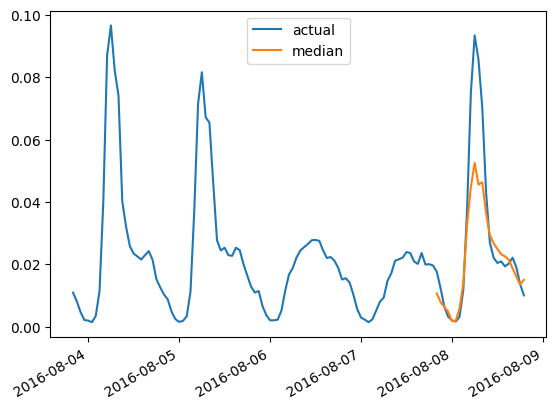
在 DLinear 上评测
gluonts 提供了一种 DLinear 的实现,我们将使用这个实现区训练、测评该算法:
from gluonts.torch.model.d_linear.estimator import DLinearEstimator
# Define the DLinear model with the same parameters as the Autoformer model
estimator = DLinearEstimator(
prediction_length=dataset.metadata.prediction_length,
context_length=dataset.metadata.prediction_length*2,
scaling=scaling,
hidden_dimension=2,
batch_size=batch_size,
num_batches_per_epoch=num_batches_per_epoch,
trainer_kwargs=dict(max_epochs=epochs)
)
训练模型:
predictor = estimator.train(
training_data=train_dataset,
cache_data=True,
shuffle_buffer_length=1024
)
>>> INFO:pytorch_lightning.callbacks.model_summary:
| Name | Type | Params
---------------------------------------
0 | model | DLinearModel | 4.7 K
---------------------------------------
4.7 K Trainable params
0 Non-trainable params
4.7 K Total params
0.019 Total estimated model params size (MB)
Training: 0it [00:00, ?it/s]
...
INFO:pytorch_lightning.utilities.rank_zero:Epoch 49, global step 5000: 'train_loss' was not in top 1
INFO:pytorch_lightning.utilities.rank_zero:`Trainer.fit` stopped: `max_epochs=50` reached.
在测试集上评测:
from gluonts.evaluation import make_evaluation_predictions, Evaluator
forecast_it, ts_it = make_evaluation_predictions(
dataset=dataset.test,
predictor=predictor,
)
d_linear_forecasts = list(forecast_it)
d_linear_tss = list(ts_it)
evaluator = Evaluator()
agg_metrics, _ = evaluator(iter(d_linear_tss), iter(d_linear_forecasts))
所以 DLinear 对应的结果是:
dlinear_mase = agg_metrics["MASE"]
print(f"DLinear MASE: {dlinear_mase:.3f}")
>>> DLinear MASE: 0.965
同样地,我们画出预测结果与 ground truth 的对比曲线图:
def plot_gluonts(index):
plt.plot(d_linear_tss[index][-4 * dataset.metadata.prediction_length:].to_timestamp(), label="target")
d_linear_forecasts[index].plot(show_label=True, color='g')
plt.legend()
plt.gcf().autofmt_xdate()
plt.show()
plot_gluonts(4)
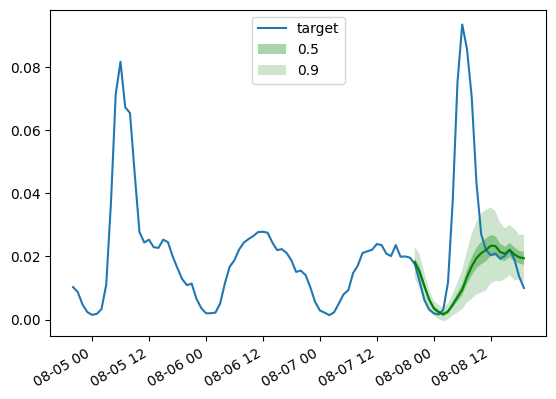
实际上, traffic 数据集在平日和周末会出现传感器中模式的分布偏移。那我们还应该怎么做呢?由于 DLinear 没有足够的能力去处理协方差信息,或者说是任何的日期时间的特征,我们给出的窗口大小无法覆盖全面,使得让模型有足够信息去知道当前是在预测平日数据还是周末数据。因此模型只会去预测更为普适的结果,这就导致其预测分布偏向平日数据,因而导致对周末数据的预测变得更差。当然,如果我们给一个足够大的窗口,一个线性模型也可以识别出周末的模式,但当我们的数据中存在以月或以季度为单位的模式分布时,那就需要更大的窗口了。
总结
所以 transformer 模型和线性模型对比的结论是什么呢?不同模型在测试集上的 MASE 指标如下所示:
| Dataset | Transformer (uni.) | Transformer (mv.) | Informer (uni.) | Informer (mv.) | Autoformer (uni.) | DLinear |
|---|---|---|---|---|---|---|
Traffic |
0.876 | 1.046 | 0.924 | 1.131 | 0.910 | 0.965 |
可以看到,我们去年引入的 最原始的 Transformer 模型 获得了最好的性能指标。其次,多变量模型一般都比对应的单变量模型更差,原因在于序列间的相关性关系一般都较难预测。额外添加的波动通常会损坏预测结果,或者模型可能会学到一些错误的相关性信息。最近的一些论文,如 CrossFormer (ICLR 23) 和 CARD 也在尝试解决这些 transformer 模型中的问题。
多变量模型通常在训练数据足够大的时候才会表现得好。但当我们与单变量模型在小的公开数据集上对比时,通常单变量模型会表现得更好。相对于线性模型,通常其相应尺寸的单变量 transformer 模型或其它神经网络类模型会表现得更好。
总结来讲,transformer 模型在时间序列预测领域,远没有达到要被淘汰的境地。
然而大规模训练数据对它巨大潜力的挖掘是至关重要的,这一点不像 CV 或 NLP 领域,时间序列预测缺乏大规模公开数据集。
当前绝大多数的时间序列预训练模型也不过是在诸如 UCR & UEA 这样的少量样本上训练的。
即使这些基准数据集为时间序列预测的发展进步提供了基石,其较小的规模和泛化性的缺失使得大规模预训练仍然面临诸多困难。
所以对于时间序列预测领域来讲,发展大规模、强泛化性的数据集 (就像 CV 领域的 ImageNet 一样) 是当前最重要的事情。这将会极大地促进时间序列分析领域与训练模型的发展研究,提升与训练模型在时间序列预测方面的能力。
声明
我们诚挚感谢 Lysandre Debut 和 Pedro Cuenca 提供的深刻见解和对本项目的帮助。 ️
英文原文:https://hf.co/blog/autoformer
作者: Eli Simhayev, Kashif Rasul, Niels Rogge
译者: Hoi2022
审校/排版: zhongdongy (阿东)
据说,Transformer 不能有效地进行时间序列预测?的更多相关文章
- 上篇 | 使用 🤗 Transformers 进行概率时间序列预测
介绍 时间序列预测是一个重要的科学和商业问题,因此最近通过使用基于深度学习 而不是经典方法的模型也涌现出诸多创新.ARIMA 等经典方法与新颖的深度学习方法之间的一个重要区别如下. 概率预测 通常,经 ...
- 下篇 | 使用 🤗 Transformers 进行概率时间序列预测
在<使用 Transformers 进行概率时间序列预测>的第一部分里,我们为大家介绍了传统时间序列预测和基于 Transformers 的方法,也一步步准备好了训练所需的数据集并定义了环 ...
- Python中利用LSTM模型进行时间序列预测分析
时间序列模型 时间序列预测分析就是利用过去一段时间内某事件时间的特征来预测未来一段时间内该事件的特征.这是一类相对比较复杂的预测建模问题,和回归分析模型的预测不同,时间序列模型是依赖于事件发生的先后顺 ...
- 时间序列预测之--ARIMA模型
什么是 ARIMA模型 ARIMA模型的全称叫做自回归移动平均模型,全称是(ARIMA, Autoregressive Integrated Moving Average Model).也记作ARIM ...
- Kesci: Keras 实现 LSTM——时间序列预测
博主之前参与的一个科研项目是用 LSTM 结合 Attention 机制依据作物生长期内气象环境因素预测作物产量.本篇博客将介绍如何用 keras 深度学习的框架搭建 LSTM 模型对时间序列做预测. ...
- 使用tensorflow的lstm网络进行时间序列预测
https://blog.csdn.net/flying_sfeng/article/details/78852816 版权声明:本文为博主原创文章,未经博主允许不得转载. https://blog. ...
- 基于 Keras 用 LSTM 网络做时间序列预测
目录 基于 Keras 用 LSTM 网络做时间序列预测 问题描述 长短记忆网络 LSTM 网络回归 LSTM 网络回归结合窗口法 基于时间步的 LSTM 网络回归 在批量训练之间保持 LSTM 的记 ...
- facebook开源的prophet时间序列预测工具---识别多种周期性、趋势性(线性,logistic)、节假日效应,以及部分异常值
简单使用 代码如下 这是官网的quickstart的内容,csv文件也可以下到,这个入门以后后面调试加入其它参数就很简单了. import pandas as pd import numpy as n ...
- (数据科学学习手札40)tensorflow实现LSTM时间序列预测
一.简介 上一篇中我们较为详细地铺垫了关于RNN及其变种LSTM的一些基本知识,也提到了LSTM在时间序列预测上优越的性能,本篇就将对如何利用tensorflow,在实际时间序列预测任务中搭建模型来完 ...
- Pytorch循环神经网络LSTM时间序列预测风速
#时间序列预测分析就是利用过去一段时间内某事件时间的特征来预测未来一段时间内该事件的特征.这是一类相对比较复杂的预测建模问题,和回归分析模型的预测不同,时间序列模型是依赖于事件发生的先后顺序的,同样大 ...
随机推荐
- vulnhub靶场之DRIFTINGBLUES: 5
准备: 攻击机:虚拟机kali.本机win10. 靶机:DriftingBlues: 5,下载地址:https://download.vulnhub.com/driftingblues/driftin ...
- 【Git GitHub Idea集成】
1 Git介绍 分布式版本控制工具 VS 集中式版本控制工具 git是一个免费开源的分布式版本控制系统,可以快速高效地处理从小型到中型的各种项目. 1.1 Git进行版本控制 集中式版本控制工具:如C ...
- Docker Go语言程序的编译与打包
使用Docker打包Go程序的镜像 Golang镜像 首先使用docker pull获取golang镜像 $ sudo docker pull golang:1.18.3 查看镜像: $ sudo d ...
- Selenium 元素定位方式封装的实际应用
一.定位方式 二.实际应用 1.项目结构 2.locator_base.py 文件 # -*- coding: utf-8 -*- from selenium.webdriver.common.by ...
- 2023-01-09:以下go语言代码输出什么?A:+Inf; B:zero; C:something else; D:doesn‘t compile。 package main import (
2023-01-09:以下go语言代码输出什么?A:+Inf: B:zero: C:something else: D:doesn't compile. package main import ( & ...
- 2022-09-09:给定一个正整数 n,返回 连续正整数满足所有数字之和为 n 的组数 。 示例 1: 输入: n = 5 输出: 2 解释: 5 = 2 + 3,共有两组连续整数([5],[2,
2022-09-09:给定一个正整数 n,返回 连续正整数满足所有数字之和为 n 的组数 . 示例 1: 输入: n = 5 输出: 2 解释: 5 = 2 + 3,共有两组连续整数([5],[2,3 ...
- 百度飞桨(PaddlePaddle) - PaddleOCR 文字识别简单使用
百度飞桨(PaddlePaddle)安装 OCR 文字检测(Differentiable Binarization --- DB) OCR的技术路线 PaddleHub 预训练模型的网络结构是 DB ...
- Sql Server维护计划事务日志找不到目标数据库
1.发现事务日志备份突然停止了 2.查看维护计划中的事务日志设置 3.发现备份任务中,事务日志需要指向的数据库不在 4.进入数据库属性 5.在选项中将恢复模式改为"完整"
- Django admin管理工具的使用、定制及源码解析
admin组件使用 Django 提供了基于 web 的管理工具. Django 自动管理工具是 django.contrib 的一部分.你可以在项目的 settings.py 中的 INSTALLE ...
- Java的CAS操作
介绍 CAS 技术是为了解决问题而生的,通过 CAS 我们可以以无锁的方式,保证对共享数据进行 "读取 - 修改 - 写回" 操作序列的正确性. CAS 是乐观锁设计思想的实现.C ...
